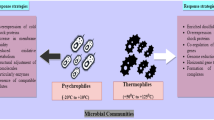Summary
Heterogeneous collections of covalently-closed circular DNA (cccDNA) comprise up to 10% of the total DNA of H. halobium and four other halophilic strains (SB3, GRA, GRB and GN101) recently isolated from different sources. All of these bacteria have purple membrane, bacterioruberin and gas vacuoles as characteristic phenotypic markers. Most of the major cccDNA species of these isolates are not homologous to pHH1, the main 150 kb cccDNA of H. halobium NRC817. Only GN101 and SB3 have a cccDNA which is partly homologous to pHH1. In GN101 the homology is to the halobacterial insertion sequence ISH23 found in pHH1. In SB3 the homology is to ISH26, a new insertion sequence isolated from H. halobium NRC817 which has a size of 1,400 bp. Extensive homologies mologies exist between the minor cccDNA species in all five strains indicating that this cccDNA species is highly conserved and possibly originates from (or is part of) the chromosome.
A 1.6 kb high copy number cccDNA species is present in three independently isolated GN101, GRB and SB3. This 1.6 kb cccDNA is not homologous to any other extrachromosomal or chromosomal DNA.
Similar content being viewed by others
References
Betlach M, Pfeifer F, Friedmann J, Boyer HW (1983) Bacterioopsin mutants of Halobacterium halobium. Proc Natl Acad Sci USA 80:1416–1420
Bolivar F, Rodriguez RL, Greene PJ, Betlach MC, Heynecker HL, Boyer HW, Crosa JH, Falkow SN (1977) Construction and characterization of new cloning vehicles II, multiple purpose cloning system. Gene 2:95–113
Bünemann H, Müller W (1978) Basespecific fractionation of double stranded DNA: Affinity chromatography on a novel type of adsorbant. Nucl Acid Res 5:1059–1074
Chang ACJ, Cohen SN (1978) Construction and characterization of amplifiable multicopy DNA cloning vehicles derived from the P15A cryptic miniplasmid. J Bacteriol 134:1141–1156
DasSarma S, RajBhandary UL, Khorana HG (1983) High frequency spontaneous mutations in the bacterio-opsin gene in Halobacterium halobium are mediated by transposable elements. Proc Natl Acad Sci USA 80:2201–2205
Goebel W (1970) Studies on extrachromosomal DNA elements. Eur J Biochem 15:311–320
Hohn B, Collins J (1980) A small cosmid for efficient cloning of large DNA fragments. Gene 11:291–298
Moore RL, McCarthy BJ (1969) Characterization of the desoxyribonucleic acid of various strains of halophilic bacteria. J Bacteriol 99:248–254
Pfeifer F, Weidinger G, Goebel W (1981a) Characterization of plasmids in Halobacteria. J Bacteriol 145:369–374
Pfeifer F, Weidinger G, Goebel W (1981b) Genetic variability in Halobacterium halobium. J Bacteriol 145:375–381
Pfeifer F, Ebert K, Weidinger G, Goebel W (1982) Structure and functions of chromosomal and extrachromosomal DNA in Halobacteria. Zentralbl Bakt Hyg I. Abt Orig C 3, 110–119
Pfeifer F, Betlach M, Martienssen R, Friedman J, Boyer HW (1983) Transposable elements of Halobacterium halobium. Mol Gen Genet 191:182–188
Rigby PWF, Dieckman M, Rhodes C, Berg P (1977) Labelling desoxyribonucleic acid to high specific activity in vitro by nicktranslation with DNA polymerase I. J Mol Biol 113:237–251
Simon RD (1978) Halobacterium strain 5 contains a plasmid which is correlated with the presence of gas vacuoles. Nature (London) 273:314–317
Simsek M, DasSarma S, RajBhandary UL, Khorana HG (1982) A transposable element from Halobacterium halobium which inactivates the bacteriorhodopsin gen. Proc Natl Acad Sci USA 79:7268–7273
Southern EM (1975) Detection of specific sequences among DNA fragments separated by gel electrophoresis. J Mol Biol 98:503–517
Weidinger G, Klotz G, Goebel W (1979) A large plasmid from Halobacterium halobium carrying genetic information for gas vacuole formation. Plasmid 2:377–386
Weidinger G, Pfeifer F, Goebel W (1982) Plasmids in Halobacteria: Restriction maps. In: Packer L (ed) Methods in enzymology, vol 88. Academic Press, New York, p. 374
Woese C (1980) Sci Am 244:94–106
Author information
Authors and Affiliations
Additional information
Communicated by E. Bautz
Rights and permissions
About this article
Cite this article
Ebert, K., Goebel, W. & Pfeifer, F. Homologies between heterogeneous extrachromosomal DNA populations of Halobacterium halobium and four new halobacterial isolates. Molec. Gen. Genet. 194, 91–97 (1984). https://doi.org/10.1007/BF00383502
Received:
Issue Date:
DOI: https://doi.org/10.1007/BF00383502




